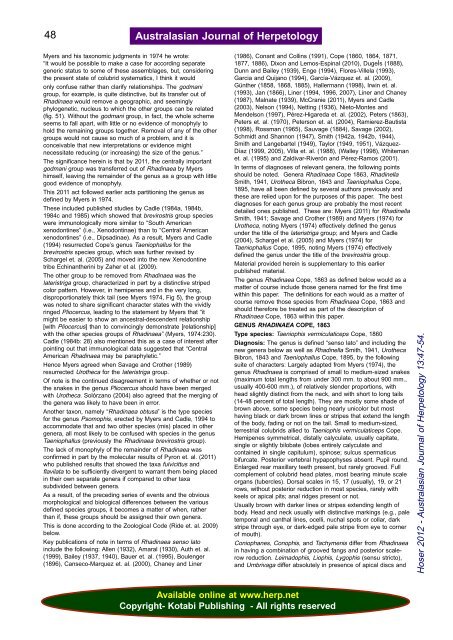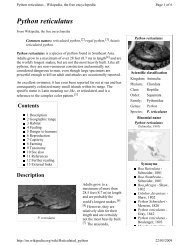Issue Thirteen 30 June 2012 - Taxonomic issue - all - Smuggled.com
Issue Thirteen 30 June 2012 - Taxonomic issue - all - Smuggled.com
Issue Thirteen 30 June 2012 - Taxonomic issue - all - Smuggled.com
Create successful ePaper yourself
Turn your PDF publications into a flip-book with our unique Google optimized e-Paper software.
48<br />
Myers and his taxonomic judgments in 1974 he wrote:<br />
“It would be possible to make a case for according separate<br />
generic status to some of these assemblages, but, considering<br />
the present state of colubrid systematics, I think it would<br />
only confuse rather than clarify relationships. The godmani<br />
group, for example, is quite distinctive, but its transfer out of<br />
Rhadinaea would remove a geographic, and seemingly<br />
phylogenetic, nucleus to which the other groups can be related<br />
(fig. 51). Without the godmani group, in fact, the whole scheme<br />
seems to f<strong>all</strong> apart, with little or no evidence of monophyly to<br />
hold the remaining groups together. Removal of any of the other<br />
groups would not cause so much of a problem, and it is<br />
conceivable that new interpretations or evidence might<br />
necessitate reducing (or increasing) the size of the genus.”<br />
The significance herein is that by 2011, the centr<strong>all</strong>y important<br />
godmani group was transferred out of Rhadinaea by Myers<br />
himself, leaving the remainder of the genus as a group with little<br />
good evidence of monophyly.<br />
This 2011 act followed earlier acts partitioning the genus as<br />
defined by Myers in 1974.<br />
These included published studies by Cadle (1984a, 1984b,<br />
1984c and 1985) which showed that brevirostris group species<br />
were immunologic<strong>all</strong>y more similar to “South American<br />
xenodontines” (i.e., Xenodontinae) than to “Central American<br />
xenodontines” (i.e., Dipsadinae). As a result, Myers and Cadle<br />
(1994) resurrected Cope’s genus Taenioph<strong>all</strong>us for the<br />
brevirostris species group, which was further revised by<br />
Schargel et. al. (2005) and moved into the new Xenodontine<br />
tribe Echinantherini by Zaher et al. (2009).<br />
The other group to be removed from Rhadinaea was the<br />
lateristriga group, characterized in part by a distinctive striped<br />
color pattern. However, in hemipenes and in the very long,<br />
disproportionately thick tail (see Myers 1974, Fig 5), the group<br />
was noted to share significant character states with the vividly<br />
ringed Pliocercus, leading to the statement by Myers that “it<br />
might be easier to show an ancestral-descendent relationship<br />
[with Pliocercus] than to convincingly demonstrate [relationship]<br />
with the other species groups of Rhadinaea” (Myers, 1974:2<strong>30</strong>).<br />
Cadle (1984b: 28) also mentioned this as a case of interest after<br />
pointing out that immunological data suggested that “Central<br />
American Rhadinaea may be paraphyletic.”<br />
Hence Myers agreed when Savage and Crother (1989)<br />
resurrected Urotheca for the lateristriga group.<br />
Of note is the continued disagreement in terms of whether or not<br />
the snakes in the genus Pliocercus should have been merged<br />
with Urotheca. Solórzano (2004) also agreed that the merging of<br />
the genera was likely to have been in error.<br />
Another taxon, namely “Rhadinaea obtusa” is the type species<br />
for the genus Psomophis, erected by Myers and Cadle, 1994 to<br />
ac<strong>com</strong>modate that and two other species (mis) placed in other<br />
genera, <strong>all</strong> most likely to be confused with species in the genus<br />
Taenioph<strong>all</strong>us (previously the Rhadinaea brevirostris group).<br />
The lack of monophyly of the remainder of Rhadinaea was<br />
confirmed in part by the molecular results of Pyron et. al. (2011)<br />
who published results that showed the taxa fulvicittus and<br />
flavilata to be sufficiently divergent to warrant them being placed<br />
in their own separate genera if <strong>com</strong>pared to other taxa<br />
subdivided between genera.<br />
As a result, of the preceding series of events and the obvious<br />
morphological and biological differences between the various<br />
defined species groups, it be<strong>com</strong>es a matter of when, rather<br />
than if, these groups should be assigned their own genera.<br />
This is done according to the Zoological Code (Ride et. al. 2009)<br />
below.<br />
Key publications of note in terms of Rhadinaea senso lato<br />
include the following: Allen (1932), Amaral (19<strong>30</strong>), Auth et. al.<br />
(1999), Bailey (1937, 1940), Bauer et. al. (1995), Boulenger<br />
(1896), Canseco-Marquez et. al. (2000), Chaney and Liner<br />
Australasian Journal of Herpetology<br />
(1986), Conant and Collins (1991), Cope (1860, 1864, 1871,<br />
1877, 1886), Dixon and Lemos-Espinal (2010), DugeÌs (1888),<br />
Dunn and Bailey (1939), Enge (1994), Flores-Villela (1993),<br />
Garcia and Quijano (1994), García-Vázquez et. al. (2009),<br />
Günther (1858, 1868, 1885), H<strong>all</strong>ermann (1998), Irwin et. al.<br />
(1993), Jan (1866), Liner (1994, 1996, 2007), Liner and Chaney<br />
(1987), Malnate (1939), McCranie (2011), Myers and Cadle<br />
(2003), Nelson (1994), Netting (1936), Nieto-Montes and<br />
Mendelson (1997), Pérez-Higareda et. al. (2002), Peters (1863),<br />
Peters et. al. (1970), Peterson et. al. (2004), Ramierez-Bautista<br />
(1998), Rossman (1965), Sauvage (1884), Savage (2002),<br />
Schmidt and Shannon (1947), Smith (1942a, 1942b, 1944),<br />
Smith and Langebartel (1949), Taylor (1949, 1951), Vázquez-<br />
Díaz (1999, 2005), Villa et. al. (1988), (W<strong>all</strong>ey (1998), Whiteman<br />
et. al. (1995) and Zaldivar-Riverón and Pérez-Ramos (2001).<br />
In terms of diagnoses of relevant genera, the following points<br />
should be noted. Genera Rhadinaea Cope 1863, Rhadinella<br />
Smith, 1941, Urotheca Bibron, 1843 and Taenioph<strong>all</strong>us Cope,<br />
1895, have <strong>all</strong> been defined by several authors previously and<br />
these are relied upon for the purposes of this paper. The best<br />
diagnoses for each genus group are probably the most recent<br />
detailed ones published. These are: Myers (2011) for Rhadinella<br />
Smith, 1941; Savage and Crother (1989) and Myers (1974) for<br />
Urotheca, noting Myers (1974) effectively defined the genus<br />
under the title of the lateristriga group; and Myers and Cadle<br />
(2004), Schargel et al. (2005) and Myers (1974) for<br />
Taenioph<strong>all</strong>us Cope, 1895, noting Myers (1974) effectively<br />
defined the genus under the title of the brevirostris group.<br />
Material provided herein is supplementary to this earlier<br />
published material.<br />
The genus Rhadinaea Cope, 1863 as defined below would as a<br />
matter of course include those genera named for the first time<br />
within this paper. The definitions for each would as a matter of<br />
course remove those species from Rhadinaea Cope, 1863 and<br />
should therefore be treated as part of the description of<br />
Rhadinaea Cope, 1863 within this paper.<br />
GENUS RHADINAEA COPE, 1863<br />
Type species: Taeniophis vermiculaticeps Cope, 1860<br />
Diagnosis: The genus is defined “senso lato” and including the<br />
new genera below as well as Rhadinella Smith, 1941, Urotheca<br />
Bibron, 1843 and Taenioph<strong>all</strong>us Cope, 1895, by the following<br />
suite of characters: Largely adapted from Myers (1974), the<br />
genus Rhadinaea is <strong>com</strong>prised of sm<strong>all</strong> to medium-sized snakes<br />
(maximum total lengths from under <strong>30</strong>0 mm. to about 900 mm.,<br />
usu<strong>all</strong>y 400-600 mm.), of relatively slender proportions, with<br />
head slightly distinct from the neck, and with short to long tails<br />
(14-48 percent of total length). They are mostly some shade of<br />
brown above, some species being nearly unicolor but most<br />
having black or dark brown lines or stripes that extend the length<br />
of the body, fading or not on the tail. Sm<strong>all</strong> to medium-sized,<br />
terrestrial colubrids <strong>all</strong>ied to Taeniophis vermiculaticeps Cope.<br />
Hemipenes symmetrical, dist<strong>all</strong>y calyculate, usu<strong>all</strong>y capitate,<br />
single or slightly bilobate (lobes entirely calyculate and<br />
contained in single capitulum), spinose; sulcus spermaticus<br />
bifurcate. Posterior vertebral hypapophyses absent. Pupil round.<br />
Enlarged rear maxillary teeth present, but rarely grooved. Full<br />
<strong>com</strong>plement of colubrid head plates, most bearing minute scale<br />
organs (tubercles). Dorsal scales in 15, 17 (usu<strong>all</strong>y), 19, or 21<br />
rows, without posterior reduction in most species, rarely with<br />
keels or apical pits; anal ridges present or not.<br />
Usu<strong>all</strong>y brown with darker lines or stripes extending length of<br />
body. Head and neck usu<strong>all</strong>y with distinctive markings (e.g., pale<br />
temporal and canthal lines, ocelli, nuchal spots or collar, dark<br />
stripe through eye, or dark-edged pale stripe from eye to corner<br />
of mouth).<br />
Coniophanes, Conophis, and Tachymenis differ from Rhadinaea<br />
in having a <strong>com</strong>bination of grooved fangs and posterior scalerow<br />
reduction. Leimadophis, Liophis, Lygophis (sensu stricto),<br />
and Umbrivaga differ absolutely in presence of apical discs and<br />
Available online at www.herp.net<br />
Copyright- Kotabi Publishing - All rights reserved<br />
Hoser <strong>2012</strong> - Australasian Journal of Herpetology 13:47-54.



